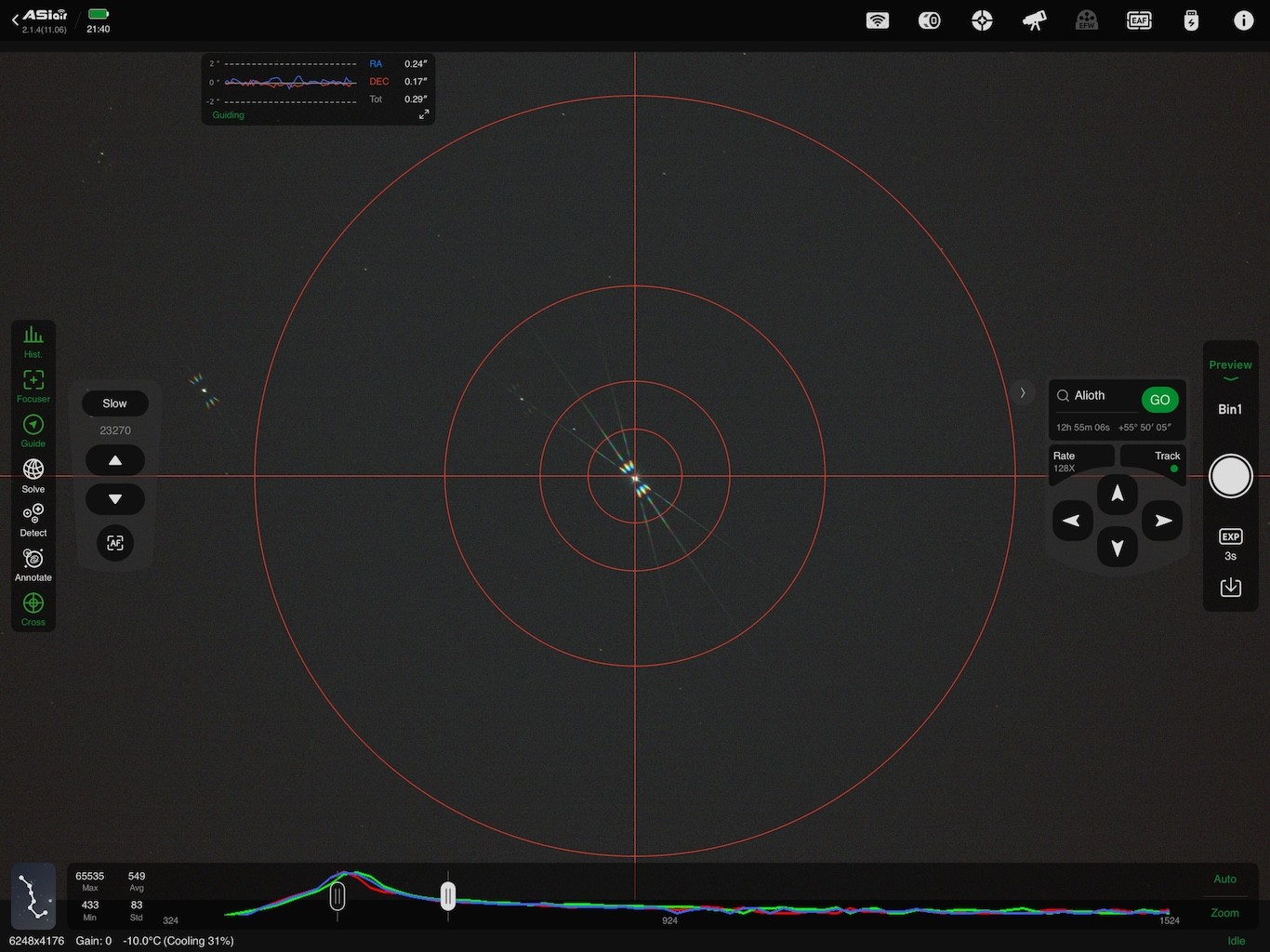Ah, so nice to be back to real astrographs; no weird image planes of a lens with umpteen elements... I spent a little time tonight (before clouds came in) testing prefilter, and backfocus of FSQ-85 using the EAF ∆ between optical center and corner.
The image train consists of the FSQ, a Pegasus 54mm male-male adapter, the Askar backfocus adjuster, the ZWO filter drawer and an ASI2600MC. The Pegasus adapter has a 2" filter thread, where I placed a Baader CMOS UV/IR cut filter (the "prefilter") that is transplanted into an Optolong 2" filter holder (because the Baader filter holder does not thread properly into the Pegasus).
First, I started with an empty filter holder in the filter, and Askar backfocus adjuster set to 18mm+0.
With the empty ZWO filter drawer, and the Bahtinov mask focused, I see this with Alioth at the optical center:

I moved Alioth to the corner (ASI2600MC, thus APS-C size frame), without changing EAF focus, and see this:

As expected with the Askar adjuster set to 18mm, the corner star is still in focus. The image plane is flat (at least at two spots) with the Askar set to 0 offset. I.e., EAF ∆ is equal to zero. No refocusing needed.
Now, here is the interesting thing. The filter thicknesses are not what I expected (from specs) when I used a thickness guage (filter between two lens paper, and the gauge zeroed with the two lens paper). The Astronomik L1 glass is not 1.1mm, but is 1.2mm thick. The Optolong UV/IR cut is not 2mm thick, but 1.85mm thick. The Optolong L-eNhanced is also not 2mm thick, but 2.2mm thick! The IDAS HEUIB-II is not 2mm thick, but 2.5mm thick. And the Chroma is 3.5mm thick, not 3mm thick.
With those glasses, the EAF ∆ looks like this:

Both the no-filter case and the Astronomik L1 (1.2mm glass) case produced close to zero EAF ∆. I then tried to roughly linear regress the data (and got the dotted line). The EAF ∆ is much closer to what I would expect the backfocus method to produce.
The regression crosses zero at 1.25mm of glass. Since I will be testing the IDAS NBZ II filter (same thickness as the IDAS HEUIB-II) for halos, the difference in glass thickness from EAF ∆ = 0 is 2.5mm - 1.25mm or 1.25mm worth of glass. Using 1/3 glass to air, that comes to about 0.4mm difference in backfocus.
So, I dialed in 18mm+0.4mm on the Askar backfocus adjuster, and measured the EAF ∆ again, this time with the NBZ II filter in the ZWO drawer. Well, instead of EAF ∆ of about 30 (the HEUIB ∆ in the graph above), the EAF ∆ is now 0, i.e., the image plane is flat, as far as I can tell!
Given any glass thickness, which we can measure using thickness gauge, we can use that dotted line to find the backfocus!
Alioth looks like this with the NBZ filter:

Magnified:

I think I see a light halo, but also a spike, which I have not seen before on the FSQ. The spike is coming from either the Optolong filter holder that the Baader pre-filter is located in, or from the Askar adjuster, or the NBZ itself.
Unfortunately as I was trying to get a stack of the image, the background started to get bright: nearly full moon plus clouds. So it will take a different night to see how strong the halo is, and where the spike is coming from.
To remove the Optolong filter holder as the culprit, I transplanted the Baader filter into a SVBONY UV/IIR filter's holder for the next night. If the problem is from the Askar adjuster, I would need to go back to use regular spacers or custom PreciseParts spacer. But at least I know the backfocus I need.
However, I do see a glitch on the NBZ:

I have to see where that is coming from -- I think it is the retaining ring of the filter, so I may nhave to replace it with the retaining ring from some other 2" filter, to see if the diffraction spike goes away.
But the good news is that the EAF ∆ method to determine backfocus works!
Chen